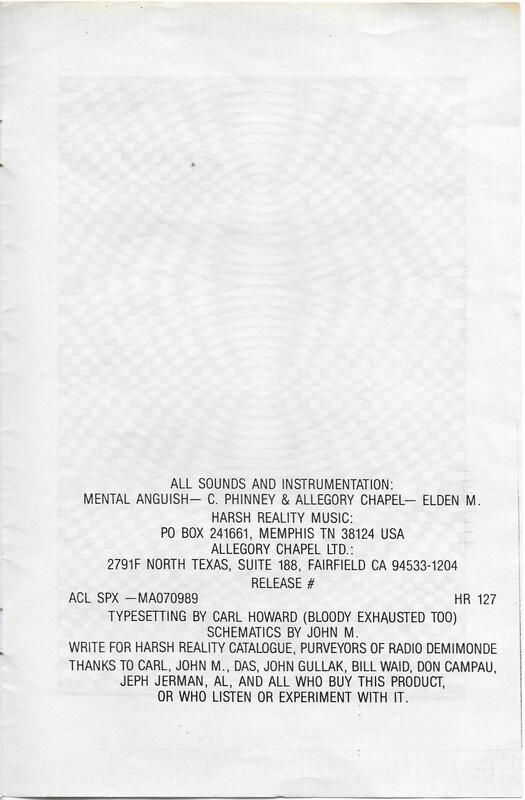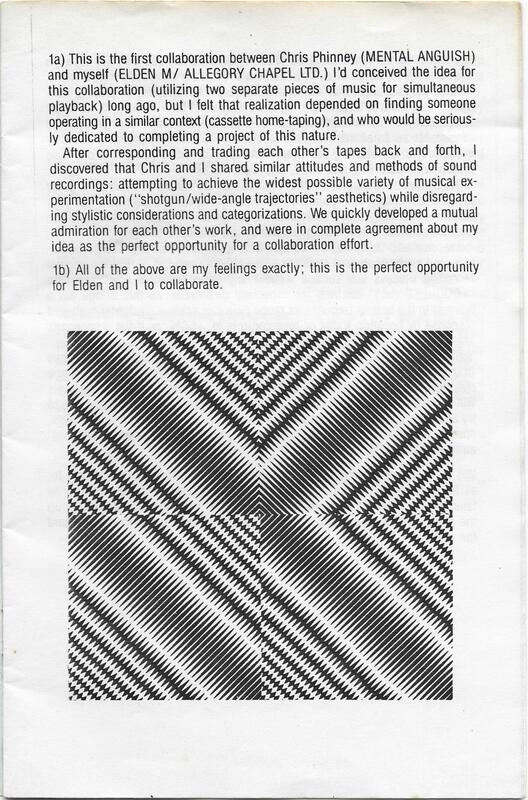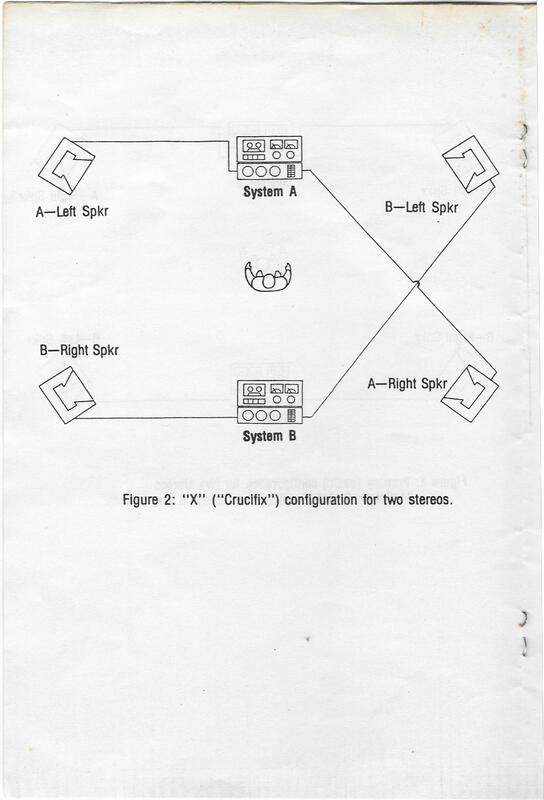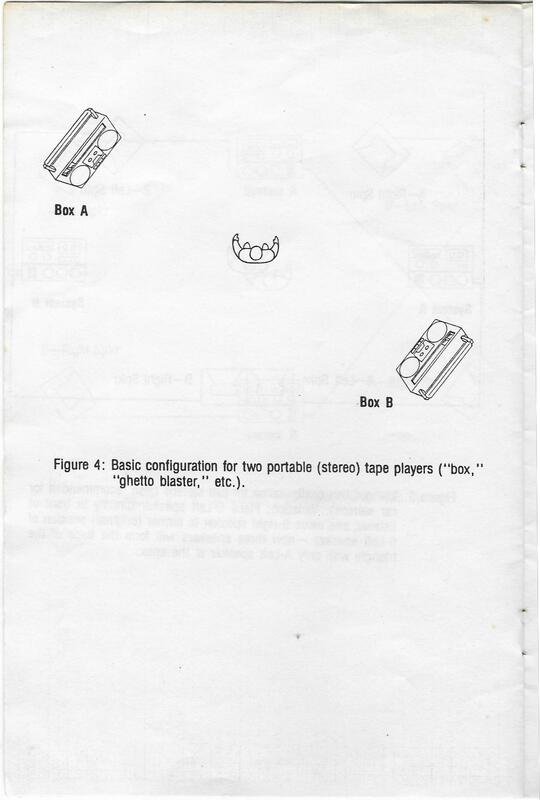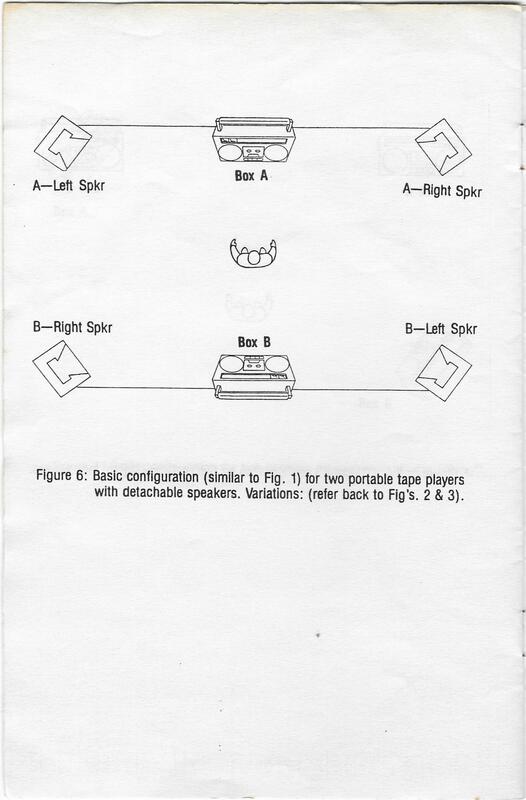HR127 - Mental Anguish & Allegory Chapel - Acoustically Coordinated Environments: Music For Tandem Stereo Systems - 2 x C60 — 1989
REVIEW by Jerry Kranitz
Acoustically Coordinated Environments: Music For Tandem Stereo Systems is a collaboration between Mental Anguish (Chris Phinney) and Allegory Chapel (Elden M.). The 2-tape set consists of solo recordings from each artist and, as the title indicates, are intended to be played simultaneously. It’s immediately clear that there are lots of possibilities for the ambitious listener to have a fun and varied experience, as the tape can be enjoyed in multiple ‘configurations’.
To set a baseline for the tandem experience I started by listening to each tape alone. Mental Anguish Side A is a minimally evolving deep space exploration, with rolling drones, buzzing waves, gurgling effects, and more. It’s like an alien forest in the engine room of a space station. I like the mesmerizing balance between intensity and cosmic drift. Side B is similar but is both eerier and dreamier and includes spaced out foghorn and trumpet sounds which add a great mood effect to the music.
Allegory Chapel Side A begins as pure wind tunnel drone, weaving a coldly determined path. It’s punctuated at times by other occurrences, like brief whizzing electronic chirps, background voice samples, rattling chains, grinding wheels, ghostly howls, melodies, and choral chants. And all the while the drone marches on, gradually increasing in intensity. But after the halfway mark the wind tunnel transitions to a series of constantly shifting themes, from aquatic, spiraling cavern buzzing with life, before going full blown tribal, then cosmically choral, to sound exploratory collage. And this final bit is what sets the tone for the entirety of Side B.
With two very different sets, how do the two come together? The notes in the accompanying booklet shown below the interview detail a variety of options. Here’s what I did: The tapes were not available to me, and I couldn’t have played both at the same time if they were. But even in the digital age I was able to take on the artists’ challenge. I opened both files in Audacity, which facilitated simultaneous play.
First, I played the Mental Anguish and Allegory Chapel A side files in tandem, followed by the B sides. And sure enough, we’ve got the wind tunnel rocketing into space, with a killer combo of drone colored by fun alien effects. And as each component progresses, the tandem effect becomes a densely churning symbiosis of industrial and floating space electronica, music, drone, and busily, often chaotically layered effects. And the B sides are an intriguing blend of space exploration, drifting noise, and effects.
Next, I opened the Mental Anguish A and Allegory Chapel B side files, followed by B and A. While the overall theme is the same, it’s as if the artists were allowing a single work to continue unfolding. That is, if this were a double tape set with the A+A and B+B sides being Tape 1, and the A+B and B+A sides being Tape 2. For pure space exploration with lots of effects and variety, my favorite is the combination of A+B and B+A.
One example of someone who explored the possibilities of this set was Gen Ken Montgomery, a hometaper who also ran the Generator art and performance space in New York City. Ken had befriended the late Conrad Schnitzler and ‘conducted’ cassette concerts of Schnitzler’s work, as well as making many of his own cassette concerts. When Ken re-created Generator for the 2012 exhibition at AVA gallery he presented many concerts using the multiple cassette format, including the Mental Anguish/Allegory Chapel Music For Tandem Stereo Systems.
Acoustically Coordinated Environments: Music For Tandem Stereo Systems is a collaboration between Mental Anguish (Chris Phinney) and Allegory Chapel (Elden M.). The 2-tape set consists of solo recordings from each artist and, as the title indicates, are intended to be played simultaneously. It’s immediately clear that there are lots of possibilities for the ambitious listener to have a fun and varied experience, as the tape can be enjoyed in multiple ‘configurations’.
To set a baseline for the tandem experience I started by listening to each tape alone. Mental Anguish Side A is a minimally evolving deep space exploration, with rolling drones, buzzing waves, gurgling effects, and more. It’s like an alien forest in the engine room of a space station. I like the mesmerizing balance between intensity and cosmic drift. Side B is similar but is both eerier and dreamier and includes spaced out foghorn and trumpet sounds which add a great mood effect to the music.
Allegory Chapel Side A begins as pure wind tunnel drone, weaving a coldly determined path. It’s punctuated at times by other occurrences, like brief whizzing electronic chirps, background voice samples, rattling chains, grinding wheels, ghostly howls, melodies, and choral chants. And all the while the drone marches on, gradually increasing in intensity. But after the halfway mark the wind tunnel transitions to a series of constantly shifting themes, from aquatic, spiraling cavern buzzing with life, before going full blown tribal, then cosmically choral, to sound exploratory collage. And this final bit is what sets the tone for the entirety of Side B.
With two very different sets, how do the two come together? The notes in the accompanying booklet shown below the interview detail a variety of options. Here’s what I did: The tapes were not available to me, and I couldn’t have played both at the same time if they were. But even in the digital age I was able to take on the artists’ challenge. I opened both files in Audacity, which facilitated simultaneous play.
First, I played the Mental Anguish and Allegory Chapel A side files in tandem, followed by the B sides. And sure enough, we’ve got the wind tunnel rocketing into space, with a killer combo of drone colored by fun alien effects. And as each component progresses, the tandem effect becomes a densely churning symbiosis of industrial and floating space electronica, music, drone, and busily, often chaotically layered effects. And the B sides are an intriguing blend of space exploration, drifting noise, and effects.
Next, I opened the Mental Anguish A and Allegory Chapel B side files, followed by B and A. While the overall theme is the same, it’s as if the artists were allowing a single work to continue unfolding. That is, if this were a double tape set with the A+A and B+B sides being Tape 1, and the A+B and B+A sides being Tape 2. For pure space exploration with lots of effects and variety, my favorite is the combination of A+B and B+A.
One example of someone who explored the possibilities of this set was Gen Ken Montgomery, a hometaper who also ran the Generator art and performance space in New York City. Ken had befriended the late Conrad Schnitzler and ‘conducted’ cassette concerts of Schnitzler’s work, as well as making many of his own cassette concerts. When Ken re-created Generator for the 2012 exhibition at AVA gallery he presented many concerts using the multiple cassette format, including the Mental Anguish/Allegory Chapel Music For Tandem Stereo Systems.
INTERVIEW with Chris Phinney by Jerry Kranitz
Jerry Kranitz (JK): Tell me about how you and Elden came up with the tandem idea?
Chris Phinney (CP): I had done a release for Elden’s label, Allegory Chapel Ltd., and he was going to do one for Harsh Reality, but then he came up with this idea to be released on Harsh Reality. He proposed this tandem idea that could be played 3 or 4 different ways and I thought that was a pretty good idea. He printed everything up, which you can see below this interview, depicting different stereo system setups. We designed the project to have two stereo systems. The book details multiple setup options, including listeners with boomboxes. Now of course today we’ve turned it into digital and I think your idea of running them through a DAW software is the best way for everybody to do it. Unfortunately, everybody who wants to listen to this isn’t a musician and not necessarily going to have a DAW. There are free ones out there. But they could do two PCs, or a tablet and a PC. Or they could burn two CDRs if they’ve got two options for playing CDs. I have a blurb about this on the Bandcamp page.
JK: Was there any advance discussion about or guidelines for what each of you would record on your own?
CP: There were no guidelines per se, but rather a knowledge of each other’s musical style and recording techniques and recorded with that in mind, expecting the two would gel with one another. So we approached it as recordings that the other could collaborate with. And I think I’ve got the digital synced better than the tapes were.
JK: Did you try out the tandem experience yourselves before making the tapes available?
CP: Yeah. I played around with all the different configurations. And so did Elden and then we released it.
JK: Did you talk about each of your experiences with it before releasing it?
CP: We talked about it and agreed it sounded good. I sent a copy to Gen Ken Montgomery and he sent me a CD of the way he played it at a Generator show in New York.
JK: Did you get any feedback from other listeners about their own experiences with the tapes?
CP: I did get some from people who told me about the different configurations that they liked the best.
JK: That’s great you got feedback from people who got in the trenches and experimented with it.
CP: It was a tough sell, and it’s probably a tough sell today. A lot of people can’t wrap their head around it. And they don’t have the necessary gear. Though it’s a lot easier to do today than it was back then.
JK: Oh yeah, it was easy once I realized I could open both files in Audacity and play them simultaneously.
CP: Right. Much easier digitally than with analog tapes.
JK: I noticed later in the Harsh Reality catalog: HR204 – Mental Anguish / Allegory Chapel - Music For Tandem Mystery Hearsay mix - (Mix on WEVL FM90).
CP: That’s a mix of these two tapes me and Mike Honeycutt did on his show on WEVL radio in Memphis.
JK: So you and Mike did what Ken Montgomery did but on Mike’s radio show and then later released the mix.
CP: Yes, though I didn’t release it until much later in the catalog.
JK: I had a lot of fun playing these both alone and in their various configurations. I probably could have gotten really crazy with the possibilities and combined the beginning of one with starting in the middle of the other and stuff like that. If anyone did any of what I did that shows some real interest on the listener’s part.
CP: We described all the setups in the book.
Jerry Kranitz (JK): Tell me about how you and Elden came up with the tandem idea?
Chris Phinney (CP): I had done a release for Elden’s label, Allegory Chapel Ltd., and he was going to do one for Harsh Reality, but then he came up with this idea to be released on Harsh Reality. He proposed this tandem idea that could be played 3 or 4 different ways and I thought that was a pretty good idea. He printed everything up, which you can see below this interview, depicting different stereo system setups. We designed the project to have two stereo systems. The book details multiple setup options, including listeners with boomboxes. Now of course today we’ve turned it into digital and I think your idea of running them through a DAW software is the best way for everybody to do it. Unfortunately, everybody who wants to listen to this isn’t a musician and not necessarily going to have a DAW. There are free ones out there. But they could do two PCs, or a tablet and a PC. Or they could burn two CDRs if they’ve got two options for playing CDs. I have a blurb about this on the Bandcamp page.
JK: Was there any advance discussion about or guidelines for what each of you would record on your own?
CP: There were no guidelines per se, but rather a knowledge of each other’s musical style and recording techniques and recorded with that in mind, expecting the two would gel with one another. So we approached it as recordings that the other could collaborate with. And I think I’ve got the digital synced better than the tapes were.
JK: Did you try out the tandem experience yourselves before making the tapes available?
CP: Yeah. I played around with all the different configurations. And so did Elden and then we released it.
JK: Did you talk about each of your experiences with it before releasing it?
CP: We talked about it and agreed it sounded good. I sent a copy to Gen Ken Montgomery and he sent me a CD of the way he played it at a Generator show in New York.
JK: Did you get any feedback from other listeners about their own experiences with the tapes?
CP: I did get some from people who told me about the different configurations that they liked the best.
JK: That’s great you got feedback from people who got in the trenches and experimented with it.
CP: It was a tough sell, and it’s probably a tough sell today. A lot of people can’t wrap their head around it. And they don’t have the necessary gear. Though it’s a lot easier to do today than it was back then.
JK: Oh yeah, it was easy once I realized I could open both files in Audacity and play them simultaneously.
CP: Right. Much easier digitally than with analog tapes.
JK: I noticed later in the Harsh Reality catalog: HR204 – Mental Anguish / Allegory Chapel - Music For Tandem Mystery Hearsay mix - (Mix on WEVL FM90).
CP: That’s a mix of these two tapes me and Mike Honeycutt did on his show on WEVL radio in Memphis.
JK: So you and Mike did what Ken Montgomery did but on Mike’s radio show and then later released the mix.
CP: Yes, though I didn’t release it until much later in the catalog.
JK: I had a lot of fun playing these both alone and in their various configurations. I probably could have gotten really crazy with the possibilities and combined the beginning of one with starting in the middle of the other and stuff like that. If anyone did any of what I did that shows some real interest on the listener’s part.
CP: We described all the setups in the book.
BIG thanks to Michael Thomas Jackson for loaning us the book!








